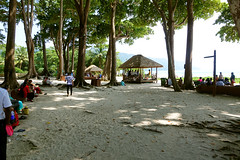A first for me on bNomadic, this time through this post I’ll share my views on two books – The Last Time I Saw Tibet and Mahatirtha Ke Antim Yatri – which are, in fact, translation of the same book in English and Hindi languages. Recuperating from a surgery, this week I got an opportunity to lay my hands on both the versions of the book which was originally written in Bangla language by the courageous wanderer Bimal Dey.
The book presents an engaging narration of the author’s adventurous journey through the highlands of Tibet at a time when the Dalai Lama still called the shots from Lhasa in the trans-Himalayan terrain. Still a teenager then, unprepared Bimal ran from his house to join a group of Lamas and trek across the harsh terrain of Tibet to visit the sacred monasteries as well as the Kailash Mansarovar. The book was first published in 1982 as Mahatirther Shesh Jatri in Bangla. Translated by Dileep Kumar Banerjee, the Hindi edition was published in 1994 as Mahatirtha Ke Antim Yatri. Penned by Malobika Chaudhuri, the English language translation was published in 2007 as The Last Time I Saw Tibet.
Through the book, Bimal Dey recounts the travels and experiences of his group expedition to Lhasa, which later became a solo adventure across Tibet, in the spring of 1956. The travel chronicles of Dey will occupy a special place in the bookshelf of a Tibet lover as it brings out the life and times of the trans-Himalayan terrain when the Fourteenth Dalai Lama was still a child and ruled Tibet. His was possibly the last recorded attempt through Tibet before the Indians were banned from travelling there without obtaining a special permission from Beijing. During those times, Sikkim was yet to be recognised as a part of India and Chinese occupation of the Tibetan territory was still marked.
By 1956, the access to Tibet was nearly closed for foreigners, particularly Indians; somehow that year Dey managed to join a group of lamas from Nepal that had managed to secure permission from the Chinese Embassy in Kathmandu for a pilgrimage to the monasteries of Tibet. Having no knowledge of religious scriptures or Tibetan and Nepali language, Dey sets off as a mauni baba, a lama who had taken a vow of silence, for the fear of getting caught by the Chinese. He receives full moral support of his Guru, the leader of the group. The group trekked across the Nathu La, through the Chumbi Valley and by the Tsangpo to reach Lhasa visiting the historical monasteries and forts on the way. What the group dreaded the most was having to deal with Chinese Army personals who were deployed just about everywhere on the way till Lhasa.
During this part of the expedition, the group visited the town of Yatung, Dungkar monastery, Phari fort and monastery, Gyantse, Kiangphu Monastery, Samding Monastery, Chaksam Monastery, Drepung Monastery as well as the Jorkhang Temple, the Norbulingka, the Potala Palace where he even had an audience with His Holiness before leaving for the holy Kailash Mansarovar region. One of the best aspects of the travelogue is the meticulous account of raw and rugged Tibetan life as well as observations and learnings from the monasteries he visited in Tibet. He separates from the group at Lhasa to continue on his own to the Kailash and Mansarovar region, the holiest pilgrimage for Hindus, Buddhists, Jains and Bonpas. All through his journey, he made friends with locals, ascetics as well as mendicants. The awe-inspiring majesty of the Himalayas is reflected throughout his expression.
Clambering over rocks and steep hills for several days in the dreary and cold terrains of Tibet, the author narrates the difficulties he had to surmount in travelling through the country. The last chapter on Lhasa includes the changes he observed in the town and Tibet after the Chinese occupation of the country. He notes the gradual decimation of the Tibetan culture including its rich and unique traditions across the countryside. Bitten by wanderlust at quite a young age, Bimal Dey undertook a mega adventurous journey of over two lakh kilometre on an ordinary bicycle from 1967 to 1972, as also the expeditions to the Arctic and Antarctica. Still it’s his journey across Tibet, from Gangtok to Lhasa and Mansarovar, which holds a special place in his heart.
I rate this book an absolutely must buy for a trans-Himalayan travels enthusiast or who feels even slightly fascinated by the terrain and culture of Tibet. Dey’s sheer neglect to material things and comforts as he undertook this arduous journey across Tibet keeps the reader in a state of awe and admiration. Comparing the two translations, I find the Hindi version more gripping and presentable. Even though, I rarely trust or subscribe to translations, the narrative flavour of the Hindi edition seems more authentic. Just hoping not much expression is lost between the translations. The English translation of the book – The Last Time I Saw Tibet – continues to be out of print on Amazon and the Hindi version – Mahatirtha Ke Antim Yatri – is available for Rs 150 on the same website.
 bNomadic
bNomadic












Get well soon. Though you are using your recovery time really well 🙂
Thanks Binu. Surgery plus winters is just a perfect time for reading and writing. Keep visiting bNomadic 😊💐
Damn, that’s another book I’ve got to try to track down. It sounds fascinating!
Absolutely Mick! You’ll surely like this book. 😊💐
I suspect so!
So glad something very positive came out of you undergoing surgery, will add the book to my ‘must read’ list, thanks!